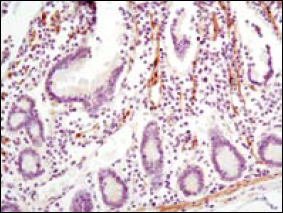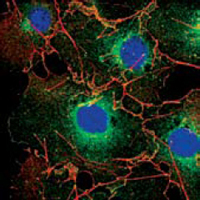LPP Monoclonal Antibody
- Catalog No.:YM0421
- Applications:WB;IHC;IF;ELISA
- Reactivity:Human;Mouse;Monkey;Hamster
- Target:
- LPP
- Gene Name:
- LPP
- Protein Name:
- Lipoma-preferred partner
- Human Gene Id:
- 4026
- Human Swiss Prot No:
- Q93052
- Mouse Gene Id:
- 210126
- Mouse Swiss Prot No:
- Q8BFW7
- Rat Swiss Prot No:
- Q5XI07
- Immunogen:
- Purified recombinant fragment of human LPP expressed in E. Coli.
- Specificity:
- LPP Monoclonal Antibody detects endogenous levels of LPP protein.
- Formulation:
- Liquid in PBS containing 50% glycerol, 0.5% BSA and 0.02% sodium azide.
- Source:
- Monoclonal, Mouse
- Dilution:
- WB 1:500 - 1:2000. IHC 1:200 - 1:1000. IF 1:200 - 1:1000. ELISA: 1:10000. Not yet tested in other applications.
- Purification:
- Affinity purification
- Storage Stability:
- -15°C to -25°C/1 year(Do not lower than -25°C)
- Other Name:
- LPP;Lipoma-preferred partner;LIM domain-containing preferred translocation partner in lipoma
- Molecular Weight(Da):
- 66kD
- References:
- 1. BMC Cell Biol. 2005 Jan 13;6(1):1
2. Mol Cell Proteomics. 2005 Sep;4(9):1240-50. Epub 2005 Jun 11.
3. Cancer Genet Cytogenet. 2005 Nov;163(1):68-70.
- Background:
- This gene encodes a member of a subfamily of LIM domain proteins that are characterized by an N-terminal proline-rich region and three C-terminal LIM domains. The encoded protein localizes to the cell periphery in focal adhesions and may be involved in cell-cell adhesion and cell motility. This protein also shuttles through the nucleus and may function as a transcriptional co-activator. This gene is located at the junction of certain disease-related chromosomal translocations, which result in the expression of chimeric proteins that may promote tumor growth. Alternative splicing results in multiple transcript variants. [provided by RefSeq, Jul 2014],
- Function:
- disease:A chromosomal aberration involving LPP is associated with a subclass of benign mesenchymal tumors known as lipomas. Translocation t(3;12)(q27-q28;q13-q15) with HMGA2 is shown in lipomas.,disease:A chromosomal aberration involving LPP is associated with acute monoblastic leukemia. Translocation t(3;11)(q28;q23) with MLL is associated with acute monoblastic leukemia.,disease:A chromosomal aberration involving LPP is associated with parosteal lipomas. Translocation t(3;12)(q28;q14) with HMGA2 is also shown in one parosteal lipoma.,disease:A chromosomal aberration involving LPP is associated with pulmonary chondroid hamartomas. Translocation t(3;12)(q27-q28;q14-q15) with HMGA2 is detected in pulmonary chondroid hamartomas.,function:May play a structural role at sites of cell adhesion in maintaining cell shape and motility. In addition to these structural functions, it may also be imp
- Subcellular Location:
- Nucleus. Cytoplasm. Cell junction. Cell membrane. Found in the nucleus, in the cytoplasm and at cell adhesion sites. Shuttles between the cytoplasm and the nucleus. It has been found in sites of cell adhesion such as cell-to-cell contact and focal adhesion which are membrane attachment sites of cells to the extracellular matrix. Mainly nuclear when fused with HMGA2/HMGIC and KMT2A/MLL1.
- Expression:
- Expressed in a wide variety of tissues but no or very low expression in brain and peripheral leukocytes.
- June 19-2018
- WESTERN IMMUNOBLOTTING PROTOCOL
- June 19-2018
- IMMUNOHISTOCHEMISTRY-PARAFFIN PROTOCOL
- June 19-2018
- IMMUNOFLUORESCENCE PROTOCOL
- September 08-2020
- FLOW-CYTOMEYRT-PROTOCOL
- May 20-2022
- Cell-Based ELISA│解您多样本WB检测之困扰
- July 13-2018
- CELL-BASED-ELISA-PROTOCOL-FOR-ACETYL-PROTEIN
- July 13-2018
- CELL-BASED-ELISA-PROTOCOL-FOR-PHOSPHO-PROTEIN
- July 13-2018
- Antibody-FAQs
- Products Images

- Western Blot analysis using LPP Monoclonal Antibody against HeLa (1), NIH/3T3 (2), COS (3), Caki (4), MCF-7 (5), HepG2 (6) and SMMC-7721 (7) cell lysate.

- Immunohistochemistry analysis of paraffin-embedded human small intestine with DAB staining using LPP Monoclonal Antibody.

- Confocal immunofluorescence analysis of COS cells using LPP Monoclonal Antibody (green). Red: Actin filaments have been labeled using DY-554 phalloidin. Blue: DRAQ5 fluorescent DNA dye.



